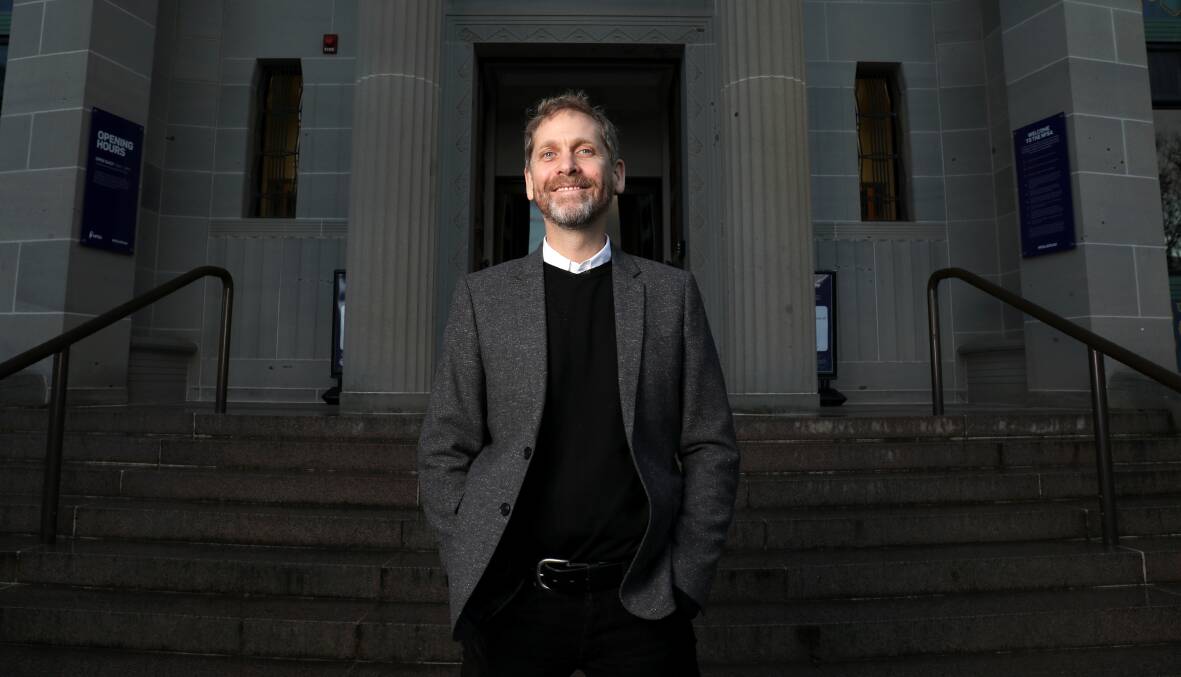
Maybe it's the sweeping stone steps and dazzling art deco detailing around the entrance, or the red velvet curtains in the lovingly restored theatrette inside.
Or perhaps it's the life-sized wax statue of Eric Bana currently in residence in the foyer, or the legendary collection of movie costumes that regularly make their way into the exhibition space.
There's always been a bit of a glitzy sheen around the National Film and Sound Archive.
And its recently appointed director, Patrick McIntyre, quite likes it that way.
He's just announced that the archive's current blockbuster exhibition, Australians & Hollywood, will be extended throughout 2023, taking advantage of the fact most of the items in the show come from its own collection, with no need to travel or be returned.
He's also settling himself into a city that has changed vastly over the decades - living in a city apartment, walking to work, and soaking up the landscape's natural charms.
And, unlike his predecessor, he has no plans to lobby for funding to shift the archive into a bespoke building.
The longtime mover and shaker in Sydney art circles - he was most recently the executive director of the Sydney Theatre Company, a role he held for nearly 12 years - took the helm of the archive in November, and has been busy getting to know the city ever since.
He says the archive's iconic building - in what was once the Institute of Anatomy and the city's first morgue - has plenty going for it, not least its location on the edge of Canberra's city centre.
This is at odds with the vision of the archive's last director, Jan Muller, who announced early in his directorship in 2018 that he would be seeking funding for a new location and building as a top priority.
He maintained at the time the move would be vital for the archive to remain relevant and achieve its purpose as the country's repository of audio-visual heritage.
He even suggested a preferred location - beside the National Museum on the Acton Peninsula.
But Mr McIntyre has already put paid to these plans.
"It's not a priority for me, for a bunch of reasons. If someone were to give us $100 million to build a new building, I would probably also build it in Civic, not on the peninsula," he told The Canberra Times.
"I kind of think that cultural institutions, as far as possible, should be right where people are, where residences are and where shops are. I think knitting institutions back into communities is something that I'd be kind of interested in pursuing.
"However, I don't think $100 million is going to be appearing at any point soon."
Instead, he said, he and his team would be "looking at inhabiting the building differently".
The grand building has been home to the archive since 1984, and has a vast, purpose-built back wing to house staff and technical studios.
"The heritage wing at the front would have to be one of Canberra's most significant buildings architecturally," Mr McIntyre said.
"And the back wing is, I think, a pretty handsome piece of 90s corporate architecture."
He said the building fulfilled the purpose of an archive, which wasn't the same as a museum - something he believes Mr Muller, who hailed from the Netherlands, wanted to change.
"If you had a tour of the annex, it's a very technologically dense workplace with lots of edit suites and sound studios and that kind of stuff, which is what we need to do the conservation and preservation work," he said.
"So we're kind of flipping and saying, why do we love the building?"
He personally loves its heritage values and the intimate, 19th-century primary school-feel of the place, which lends itself to "gathering and conversation, to actually experience and talk about the collection in smaller groups".
But he also wants the archive to have a pre-eminent role in the country's film and television landscape, as well as being a significant cultural institution.
"Psychologically, a cultural institution can be an institution in Canberra or it can be more like a media company," he said.
"I'm really interested in making sure that people identify NFSA as much with ABC and Screen Australia as they do with the National Library and the National Museum.
"I just think that in the 21st century, with digital media and the prevalence of Netflix and streaming platforms, and gaming, and all the other kinds of audio-visual cultural expressions, that NFSA should be the preeminent institution around the country."
He's also focused on a priority that long pre-dates him, the digitising of the country's most at-risk audio-visual material.
Mr McIntyre comes to the role with more than a hint of glitz himself; as well as heading up the Sydney Theatre Company, he's also had executive roles with the Australian Ballet and Sydney Film Festival, and senior marketing roles with the Sydney Dance Company and the Sydney Opera House Trust.
But he's also a country boy at heart.
"While my career has been mainly been based in Sydney, I grew up in country towns. Where you grew up as a child, and as a teenager, kind of affects you on a molecular level," he says.
"Working in an office all day, and then coming out at the end, and just smelling grass and trees and all that kind of stuff - that's what I'm really responding to at the moment."
- Australians & Hollywood is at the National Film and Sound Archive throughout 2023. nfsa.gov.au.







